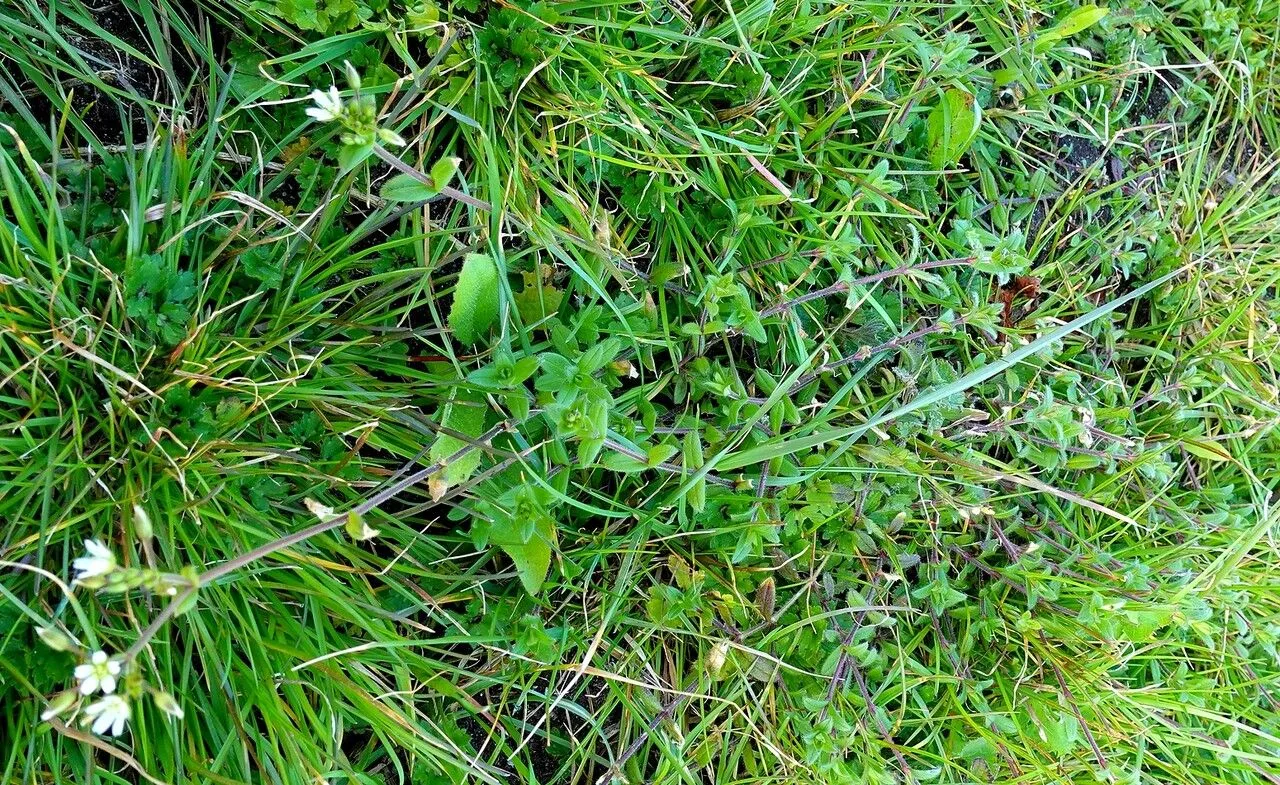
Author: Baumg.
Bibliography: Enum. Stirp. Transsilv. 1: 425 (1816)
Year: 1816
Status: accepted
Rank: species
Genus: Cerastium
Vegetable: False
Observations: N. Europe, Mts. of C. & SC. Europe, Morocco, Greenland
Common mouse-ear, scientifically known as Cerastium fontanum, is a perennial herbaceous plant belonging to the family Caryophyllaceae. This resilient species is typically found across Northern Europe and extends into the mountainous regions of Central and Southern Europe, including the diverse landscapes of Morocco and Greenland.
First described by Baumg. in 1816 within the “Enum. Stirp. Transsilv. 1: 425”, Cerastium fontanum has since gained recognition for its adaptability and widespread occurrence in various climates and altitudes. The plant thrives in a range of habitats from meadows and grasslands to woodland clearings and rocky slopes, demonstrating a remarkable capacity to flourish in both temperate and subarctic regions.
Common mouse-ear features small, white, star-shaped flowers with deeply notched petals, providing a soft contrast to its typically hairy, grayish-green foliage. These tiny yet exquisite blooms are a key identifying characteristic of the species and contribute to its common name, as the plant bears a resemblance to the ear of a mouse.
In addition to its aesthetic appeal, Cerastium fontanum plays a vital role in its ecosystems, offering shelter and food for various insects and small wildlife. The plant’s resilience and ease of growth make it a valuable species for natural landscaping and ecological restoration projects.
Whether encountered in the pristine wilderness of Greenland or the temperate highlands of Europe, the common mouse-ear stands as a testament to nature’s adaptability and the intricate beauty found in even the smallest of its creations.
Dan: almindelig hønsetarm
Eng: common chickweed, common mouse-ear, common mouse-ear chickweed, mouse-ear chickweed
Deu: quellen-hornkraut
Fra: céraiste commun, céraiste des fontaines
Nld: glanzige hoornbloem en gewone hoornbloem, gewone + glanzige hoornbloem, gewone en glanzige hoornbloem, gewone hoornbloem
Nor: kleim-arv, løen arve, veiværve, vej-arve
Swe: hönsarv
Cym: clust llygoden culddail, clust y llygoden, clust-y-llygoden gulddail, corn-wlyddyn culddail, cornwlydd cyffredin, cornwlyddyn, gwlydd y dom, gwlydd yr ieir, gwlyddyn blewog, llysiau y dom
Nob: arve
Nno: arve
En: Common mouse-ear, Common mouse-ear chickweed, Mouse-ear chickweed, Common chickweed
Be: Ясколка звычайная
Zh: 喜泉卷耳
Cs: Rožec prameništní
Da: Almindelig Hønsetarm
Nl: Gewone hoornbloem, Gewone en Glanzige hoornbloem, Glanzige hoornbloem en gewone hoornbloem, Gewone + Glanzige hoornbloem
Et: Harilik kadakkaer
Fi: Nurmihärkki
Fr: Céraiste commun, Céraiste des fontaines, Céraiste commune
De: Quellen-Hornkraut
Is: Vegarfi
Ga: Cluas luchóige choiteann
It: Peverina fontana
Gv: Cleaysh lughagh
No: Kleim-arv, Løen arve, Veiværve, Vej-arve
Nb: Arve
Nn: Arve
Pl: Rogownica źródlana
Sk: Rožec prameniskový
Sv: Hönsarv
Zh-tw: 泉卷耳
Cy: Clust-y-llygoden gulddail, Clust Llygoden Culddail, Clust y Llygoden, Corn-Wlyddyn Culddail, Cornwlydd Cyffredin, Cornwlyddyn, Gwlydd y Dom, Gwlydd yr Ieir, Gwlyddyn Blewog, Llysiau y Dom
Taken Apr 8, 2020 by MONY HD (cc-by-sa)
Taken Sep 6, 2020 by Darren Giddins (cc-by-sa)
Taken May 22, 2020 by Darren Giddins (cc-by-sa)
Taken May 5, 2008 by Henk Van Lottum (cc-by-sa)
Taken May 18, 2018 by Karla Borecky (cc-by-sa)
Taken Feb 4, 2020 by Sabina Hartmann (cc-by-sa)
Taken Dec 2, 2021 by Panthère Rose (cc-by-sa)
Taken May 14, 2022 by William Coville (cc-by-sa)
Taken Mar 22, 2022 by Pierre LEON (cc-by-sa)
Taken Mar 10, 2020 by Prieta Javier (cc-by-sa)
Taken Mar 20, 2022 by David Hocken (cc-by-sa)
Taken May 28, 2022 by Gaël Covain (cc-by-sa)
Taken Mar 21, 2022 by Pierre LEON (cc-by-sa)
Taken Mar 22, 2022 by Pierre LEON (cc-by-sa)
Taken May 14, 2022 by William Coville (cc-by-sa)
Taken Aug 29, 2021 by Pierre LEON (cc-by-sa)
Taken Jan 1, 1800 by Tela Botanica − Thierry Pernot (cc-by-sa)
Taken Jul 1, 2021 by Llandrich anna (cc-by-sa)
Taken Mar 21, 2022 by Pierre LEON (cc-by-sa)
Taken Mar 22, 2022 by Pierre LEON (cc-by-sa)
Taken Aug 24, 2021 by Terje Norli (cc-by-sa)
Taken Jun 12, 2022 by William Coville (cc-by-sa)
Taken Aug 7, 2021 by Alexander Baransky (cc-by-sa)
Taken Jan 23, 2022 by Tristan Jaton-Maria (cc-by-sa)
Taken Jul 1, 2021 by Llandrich anna (cc-by-sa)
Taken Apr 15, 2007 by Photoflora – Yann QUELEN (©)
Taken Sep 15, 2006 by Photoflora – Yann QUELEN (©)
Taken Jun 14, 2005 by Tela Botanica − Laurent PETIT (cc-by-sa)
Taken May 23, 2021 by Yvan Fischer (cc-by-sa)
Taken Jun 5, 2021 by Moshira Hassan (cc-by-sa)
© copyright of the Board of Trustees of the Royal Botanic Gardens, Kew.
© copyright of the Board of Trustees of the Royal Botanic Gardens, Kew.
Growth habit: Forb/herb
Ph maximum: 6.5
Ph minimum: 5.5
Light: 7
Atmospheric humidity: 5
Bloom months: [‘mar’, ‘apr’, ‘may’, ‘jun’, ‘jul’, ‘aug’, ‘sep’, ‘oct’]
Soil nutriments: 6
Soil salinity: 1
Family: Myrtaceae Author: (F.Muell.) K.D.Hill & L.A.S.Johnson Bibliography: Telopea 6: 402 (1995) Year: 1995 Status:…
Family: Rubiaceae Author: Pierre ex A.Froehner Bibliography: Notizbl. Bot. Gart. Berlin-Dahlem 1: 237 (1897) Year:…
Family: Sapindaceae Author: Koidz. Bibliography: J. Coll. Sci. Imp. Univ. Tokyo 32(1): 38 (1911) Year:…
Family: Asteraceae Author: A.Gray Bibliography: Pacif. Railr. Rep.: 107 (1857) Year: 1857 Status: accepted Rank:…
Family: Fabaceae Author: Medik. Bibliography: Vorles. Churpfälz. Phys.-Ökon. Ges. 2: 398 (1787) Year: 1787 Status:…
Family: Aspleniaceae Author: (Cav.) Alston Bibliography: Bull. Misc. Inform. Kew 1932: 309 (1932) Year: 1932…